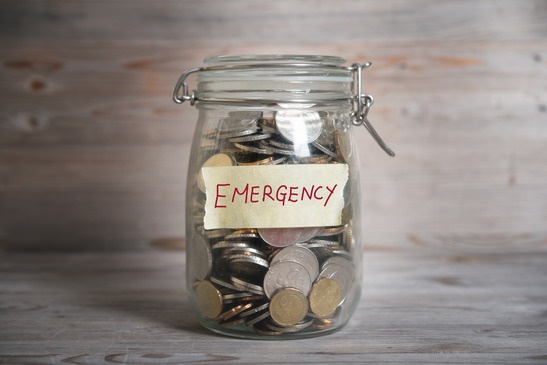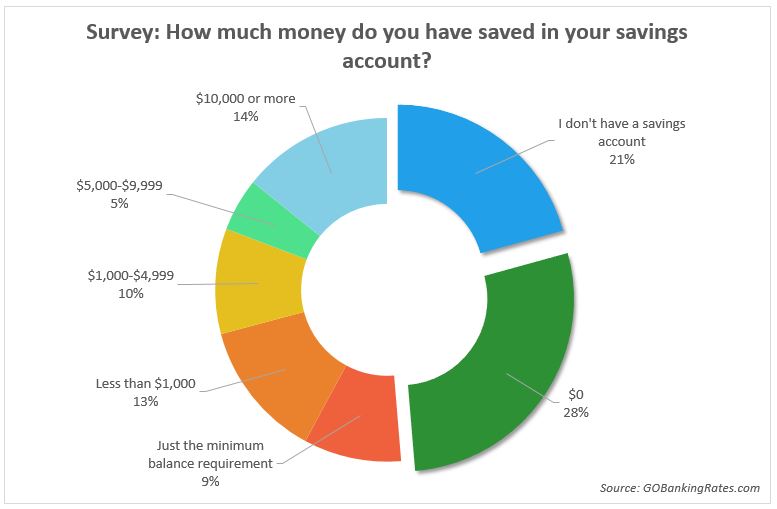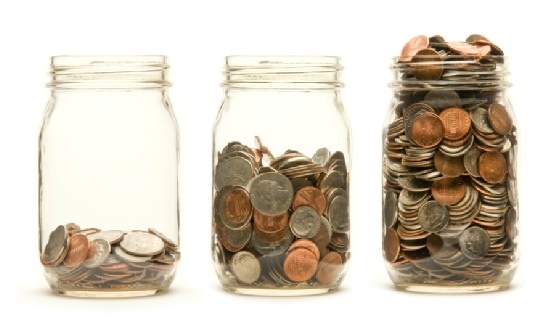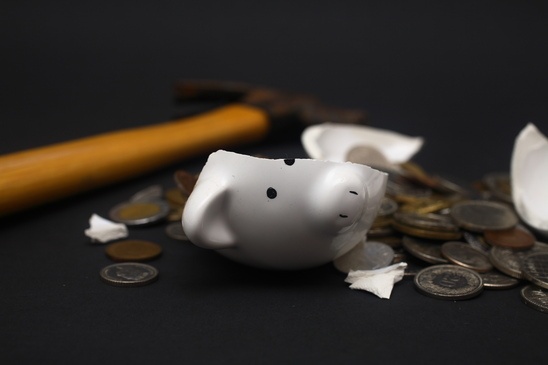“Never spend your money before you have it.” -Thomas Jefferson
Have you ever lost your job? Has your car ever required an expensive fix? Have you or a family member ever need funds for a hospital visit?
Now imagine that you didn’t have access to cash to pay for that emergency. What would you do?
The mass issuance of credit cards has allowed people to neglect the need for an emergency fund. This is a mistake. An emergency fund is not only about preparing for the rainy day that you will need the funds. It is also about reducing risk, providing you options, and helping you sleep better at night knowing that your financial emergencies do not have to be debilitating.
According to Go Banking Rates, 71% of Americans have less than $1,000 saved in their savings account. Although some age groups vary by a small margin, 70%+ of them (including seniors) have less than $1,000. If their income is cut off for even a few weeks, how are they going to survive?
What is an emergency fund?
An emergency fund is cash that you have saved that has no other purpose than to protect you from an emergency that requires cash immediately. This is one of the most commonly ignored components of financial planning. Whether it is clients we work with or new prospects, most people do not have an emergency fund. They consider it a waste of resources. Why have a pile of cash that you cannot spend just sitting there?
The nature of an emergency is that it is unexpected, urgent, and requires immediate attention. If your car dies and you need it to go to work, that is an emergency. If you get in an accident, you will need to pay for medical care. If you lose your job, you will need money to pay your bills. All of these events are urgent, unexpected, and require immediate attention. If you are not prepared for them, then you will be stressed and worried about the short term problem rather than focusing on solving the long term problem.
If you lose your job, immediately your primary concern is about how you are going to pay your bills. Until you have this figured out, you will not be focused on finding a new job. Finding a new job should be your primary goal. However, if you spend all your time on your short term need, you will not have enough time to find a new job. This is what I would call short term vs long term thinking.
Short Term Funds vs. Long Term Funds
There are some small emergencies like needing to replace a tire on your car. Then there are large emergencies like needing to replace your car completely. Most of the larger emergencies require a short term and long term solution. Here is an example.
If your car breaks and is not able to be driven, you will need to either fix it or get a new car. Buying a new car is usually an expensive option. It may be necessary, but typically it is also costly. Many people choose a short term solution until they have the time to solve the long-term problem of the broken car. A short-term solution might be to fix something that gets it running, but won’t last for more than a month when it will be back in the shop.
Your emergency fund will allow you to pay for the short term fix so that you can explore your options of buying a new car. If you are buying a new car, you probably want to take some time to research it first rather than being forced into a new one just because you don’t have a substitute.
How does financial planning help when you are building an emergency fund?
One important point to remember is that many “emergencies” are not actually emergencies, they are foreseeable expenditures that happen unexpectedly. Buying a new car every 5-10 years is a foreseeable expenditure. You may not know when your car will break, but you should know generally how long it should last.
This type of money should be saved based on a realistic financial plan or budget. If you know you will need $10,000 for a new car in 10 years (based on the car’s life expectancy), then you can save $1,000 a year to reach that goal. If your car breaks in year 9, then you will be much closer to your “emergency” need than if you had not planned at all.
The best way to plan for large expenditures in the future is to account for them in your yearly household budget. If you budget properly, then you will not stress about not having enough money for “emergency” expenses.
What is a reasonable emergency fund amount to keep?
This subject is up for debate. Most financial professionals will give you a standard answer of 3-6 months. This has been the standard for a long time. However, it is dangerous to rely on rules of thumb.
The financial services industry has some notoriously out-of-date rules of thumb that are dangerous if they are not used with some thought to what they are trying to accomplish. Here are some examples.
Many people have said, “You should have your age as the percentage of bonds you own of your portfolio”. This may be fine on the surface, but when used outside the classroom, it can endanger your portfolio. Here is an example. Currently, in the US there is a ZIRP (Zero Interest Rate Policy) meaning that if you want to put money in the bank you will get close to zero percent interest on that money. If you wanted a higher yield and put your money into 30 years Treasury bonds, you would get a higher rate, but you also risk losing money if interest rates rise. You would also miss out on getting higher rates in the future if rates rose.
Another example of financial rules of thumb being wrong. How much should you have in your emergency fund? The rule of thumb is 3-6 months. However, at closer inspection, you will realize that 3-6 months of income varies per household.
- If your household is earning $100,000, then you would be saving $25,000 to $50,000 in cash for your short term needs. This might be fine, but it depends on your expenses. If you are spending $100,000 of expenses that cannot be cut, then maybe you need more than 3-6 months worth.
- If you make $1,000,000 a year you may not need to keep $250,000-$500,000 in an emergency fund.
- If you earn $40,000 a year, then $10,000-$20,000 may not be enough of an emergency fund to pay for unexpected expenses.
If you want to figure out what your optimal emergency fund amount should be, here are a few steps to take:
- Think through all the potential expenses that might come up in the next few years (new car, dishwasher, vacations, etc) and make sure you have enough savings for those foreseeable expenses. Murphy’s Law states, “Anything that can go wrong, it will.” So when you lose your job, this is when you dishwasher will break.
- Figure out what funds you would need if you or your spouse lost your jobs. Think through how long it would take to find a new job, and add 6 months. Jobs are more likely to be lost in a bad economy. Coincidentally jobs are also harder to find during these times.
- Add $10,000-$20,000. People always underestimate what they need.
- Add up all three of the above. If you have saved these funds or more, then you should be in good shape. If not, then keep saving. You should consider adding more if you are especially conservative or risk adverse. The practical amount should be what you need plus what additional funds help you sleep at night.
- If you have exceeded the amount that the FDIC insures at your bank, make sure you diversify your risk to another bank. You might even consider splitting your risk by using 2 banks even if you are below the FDIC insured threshold.
My emergency funds or my retirement funds – What is more important?
When you are considering your financial planning needs, you should consider that your short term needs are more important than your long term needs. You have time to prepare for your long-term needs, you have little or no time to prepare for your immediate or short-term needs.
Take care of your immediate needs first then you can plan for you longer term needs.
If you find yourself constantly taking care of short-term needs at the expense of long-term needs, then you either need to earn more income or reduce your expenses.
Have you thought about where to put emergency fund savings?
There are different schools of thought on this. My thoughts are quite clear. You need to prepare for all risks by understanding what they are and coming up with solutions that address them.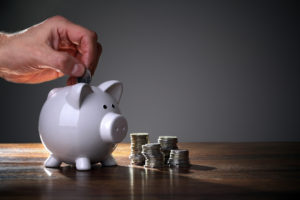
There is one thing for certain, the emergency fund needs to be:
- Liquid,
- Easily accessible,
- No risk of loss
These three things are essential to your emergency funds. If you don’t have these, then it is just a savings account. You must assume that you will need all of these funds tomorrow because you may. You never know what the future holds, but you can prepare for it.
These risks are what you need to consider with the risk management part of your financial plan:
Asset risk
I think it is prudent that people have their emergency fund entirely in cash. “Cash is King” as they say. Cash can be paper bills or FDIC insured bank accounts. Money markets are not cash, they are investments. If you remember what happened in 2008 when some money market funds were frozen due to a lack of liquidity [link], you will realize that money market funds do not meet the three criteria above. Paper bills and bank accounts have different risks, but both meet the three above requirements.
Location Risk
This risk is one that can be mitigated by diversification. If you have all your money in one bank and it files for bankruptcy, your account will be insured up to the limit ($250,000 (in 2015)). However, it may take the FDIC 3-6 months or more to pay back the savings account funds. This risk can be reduced by using multiple banks and ideally community banks, co-ops, or credit unions. If you are holding paper bills, then you should also diversify your locational risk. Physical cash can be stolen, destroyed by fire, floods or simply misplaced. As they say, “Don’t put all your eggs in one basket.”
Risk of Loss
This is the risk of losing your funds due to a number of the reasons above, bank failure, fire, theft, or mismanagement. You want to have your cash in the safest location possible. You want your risk of loss to be as close to zero as you can make it. You should ignore the idea that you should try to get the highest rate of return on your cash. Focus on safety first, then if all else being equal, focus on yields.
Risk of Theft
The risk of theft can come in all forms. This could be someone taking your physical bills, a fraud or Ponzi scheme taking advantage of you, or even the government taking your funds (as they did in Cyprus). Don’t take anything for granted.
Risk of inflation
The risk of inflation has been the primary concern for most people for the better part of the last 60 years. People are concerned that their dollars tomorrow will be worth less than they are today. This is a valid concern since inflation has been constantly positive for the past 60 years. But it does not necessarily mean that will be the case in the future. In 2015, we have started to see deflation take hold in the US and most of the global economy. Cash is one of the best assets in a deflationary period. It would be hard to predict what will happen in the future, but the risk of inflation should not be your primary concern. Losing 2% to inflation is less important than not having enough money to buy a car when you need one to do your job. Losing to inflation is a small price to pay for the ability to sleep at night knowing you have enough cash to take care of your immediate needs no matter what happens.
Risk of paper cash vs electronic cash
This is a risk that most people are not considering. Yet if you have been reading the papers in the past 5 years it should be seared into your brain. Europe is having some serious problems when it comes to fiscal responsibility. This has caused the banks of Cyprus and Greece to restrict depositors withdrawal rates at any one time. In the case of Cyprus, funds were actually confiscated from depositors. This does not happen with physical cash. While there is a higher risk of the cash being lost stolen or destroyed, it cannot be taken if it is not in the banking system.
Before you disregard the risks of the banking system and why it makes sense to keep some money outside the banking system, try to remember the period of time in the US during 2008. Stories have come out after the fact that many banking insiders were communicating with their spouses to take as much paper cash out of the banks as possible in case of failure. IF you think about how many people still use cash vs people who use debit cards or credit cards for payment, a failure of this electronic banking system would cause the majority of the population to be without access to cash or credit.
If this situation happened, as it almost did in the darkest days of 2008, wouldn’t you rather have physical cash on hand to pay for essential daily items? I think that would be smart. This is not a tinfoil hat theory that you should disregard, this is based on recent and past historical truth. If you know anyone who grew up in the great depression, ask them about the bank failures. This was a time before FDIC insurance.
What is the best way of building an emergency fund?
There is no one single way to build an emergency fund. As you know by now, an emergency fund must be tailored to your needs, not some rule of thumb. The best way to start your emergency fund is to start saving a percentage of your income each month.
There are always excuses for why you should dip into the fund, so think of the emergency fund as encased in glass. You should not dip into it because it is easy. Make it hard for yourself to access for frivolous purchases.
You need to prioritize saving for your emergency fund. Do this at the expense of your retirement or other little pleasures. Once you have a good base you can focus on other savings needs. If you are 35 years old you will have another 30 years till retirement, but you may need to access this emergency fund tomorrow. Focus on your immediate needs first.
Conclusion – emergency savings fund essentials
If you made it through this entire article, here are some simple summary tips that you should consider:
- Calculate how much you need for your emergency fund. Save enough so that you can sleep at night.
- Prioritize your emergency fund savings first.
- Make sure your emergency fund is: liquid, accessible, and risk-free
- Consider your future budgeting needs so you can reduce your “emergencies” by budgeting for them in your annual savings
- Consider all your risks as to where you keep your savings.
I hope this has been helpful. Financial planning is all about reducing your risks and planning for future needs. The more preparation you do now, the better off you will be in the future. If you want to learn more about our wealth management services, click the button below to contact us.
About the author: Kirk Chisholm is a Wealth Manager and Principal at Innovative Advisory Group. His roles at IAG are co-chair of the Investment Committee and Head of the Traditional Investment Risk Management Group. His background and areas of focus are portfolio management and investment analysis in both the traditional and alternative investment markets. He received a BA degree in Economics from Trinity College in Hartford, CT.

